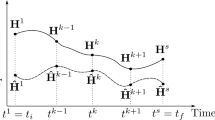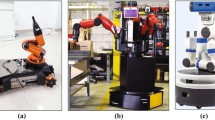Abstract
Mobile manipulators are attracting significant interest in the industrial, military, and public service communities because of the potential they provide for increased efficiency in material handling and manipulation tasks. Corresponding interest has arisen in the robotics research community since the combination and coordination of the mobility of an autonomous platform with the robotic motion of a manipulator introduce complex analytical problems. One such problem arises from the particular kinematic redundancy which characterizes practical mobile manipulators. This paper is concerned with a particular aspect of the resolution of this redundancy, which is its utilization to optimize the system's position and configuration during task commutations when changes occur in both task requirements and task constraints. Basic optimization schemes are developed for cases when load and position constraints are applied at the end-effector. Various optimization criteria are investigated for task requirements including obstacle avoidance, maneuverability and several torque functions. The problem of optimally positioning the platform for execution of a manipulation task requiring a given reach is also treated. Emphasis is then placed on the multi-criteria optimization methods which are necessary to calculate the commutation configurations in sequences of tasks with varying requirements. Sample results are presented for a system involving a three-link planar manipulator on a mobile platform. The various optimization schemes are discussed and compared, and several directions (in particular the novel use of minimax optimization pioneered here for redundancy resolution) are outlined for further extensions of the methods to the general problem of motion planning and control of redundant robotic systems with combined mobility and manipulation capabilities.
Similar content being viewed by others
References
Sousk, S.F., Pin, F.G. and Crane, C.D., Motion planning for the universal self deployable cargo handler (USDCH). in Proc. 17th U.S. Army Science Conference, Durham, North Carolina, 12–15 June 1990, Vol. 3, pp. 369–382.
McCain, H.G., et al., A hierarchically controlled autonomous robot for heavy payload military field applications. Proceedings of the International Conference on Intelligent Autonomous Systems, The Netherlands, December 8–11, 1986.
Pin, F.G., et al., Autonomous mobile robot research using the HERMIES-III robot, Proc IEEE/RJS International Workshop on Intelligent Robots and Systems, Tsukuba, Japan, September 1989, pp. 251–256.
Carriker, W.F., Khosla, P.K., and Krogh, B.H., An approach for coordinating mobility and manipulation, Proc. IEEE International Conference on Systems Engineering, Dayton, Ohio, August 1989, pp. 40–44.
Pin, F.G. and Culioli, J.-C., Multi-criteria position and configuration optimization for redundant platform/manipulator systems, Proc. IROS '90, the Third IEEE International Workshop on Intelligent Robots and Systems, Tsuchiura, Japan, 3–6 July, 1990, pp. 103–107.
Weisbin, C.R., deSaussure, G., Einstein, J.R., and Pin, F.G., Autonomous mobile robot navigation and learning, IEEE Computer 22(6), 29–35 (1989).
Hollerbach, J.M. and Suh, K.C., Redundancy resolution of manipulators through torque optimization, Proc. IEEE Conference on Robotics and Automation, St Louis, Missouri, March 1985, pp. 1016–21.
Baillieul, J., Hollerbach, J., and Brockett, R.W., Programming and control of kinematically redundant manipulators, Proc. 23rd IEEE Conference on Decision and Control, December 1984, pp. 768–74.
Yoshikawa, T., Analysis and control of robot manipulators with redundancy, in M.Brady and R.Paul (eds), Proc. Robotics Research: First International Symposium, MIT Press, Cambridge, Mass. (1984), pp. 735–48.
Konstantinov, M.S., Markov, M.D., and Nenchev, D.N., Kinematic control of redundant manipulators, Proc. 11th International Symposium on Industrial Robots, Tokyo, Japan, 1981, pp. 561–68.
Hanafusa, H., Yoshikawa, T., and Nakamura, Y., Analysis and control of articulated robot arms with redundancy, Proc. 8th IFAC World Congress, XIV, August 1981, pp. 78–83.
Klein, C.A., Use of redundancy in the design of robotic systems, Proc. 2nd International Symposium on Robotic Research, Kyoto, Japan, 1984, pp. 58–65.
Luh, J.Y.S. and Gu, Y.L., Efficiency and flexibility of industrial robots with redundancy, in M. Donath and M. Lay (eds), Proc. ASME Winter Annual Meeting, PED 15, Robotics and Manufacturing Automation (1985), pp. 37–41.
Dubey, R.V., Euler, J.A., and Babcock, S.M., An efficient projection optimization scheme for a seven-degree-of-freedom redundant robot with spherical wrist, Proc. IEEE Conference on Robotics and Automation, Philadelphia, Pennsylvania, April 1988, pp. 28–36.
Chang, P.H., A closed form solution for control of manipulators with kinematic redundancy, Proc. IEEE International Conference on Robotics and Automation, April 1986, pp. 9–14.
Wampler, C.W., Inverse kinematic functions for redundant manipulators, Proc. IEEE International Conference on Robotics and Automation, San Francisco, California, April 1987, pp. 610–17.
Nakamura, Y. and Hanafusa, H., Task priority based redundancy control of robot manipulators, in H.Hanafusa and H.Inoue (eds), Proc. Robotics Research—2nd International Symposium, MIT Press, Cambridge, Mass. (1985) pp. 155–62.
Baillieul, J., Kinematic programming alternatives for redundant manipulators, Proc. IEEE Conference on Robotics and Automation, St Louis, Missouri, March 1985, pp. 722–28.
Maciejewski, A.A. and Klein, C.A., Obstacle avoidance for kinematically redundant manipulators in dynamically varying environments, Robotics Res. 4(3), 109–117 (1985).
Martin, D.P., Baillieul, J., and Hollerbach, J.M., Resolution of kinematic redundancy using optimization techniques, IEEE Trans. Robotics Automat. 5(4), 529–533 (1989).
Shiller, Z. and Dubowsky, S., On computing the global time-optimal motions of robotic manipulators in the presence of obstacles. IEEE Trans. Robotics Automat. 7(6), 785–797 (1991).
Levy, A.V. and Gomez, S., The tunneling method applied to global optimization, in Numerical Optimization 1984, SIAM Press, Philadelphia, Pennsylvania (1984), pp. 213–44.
Wolfram, S., Mathematica ™, Addison-Wesley, Redwood City, California (1988).
Dem'yanov, V.F. and Malozemov, V.N., Introduction to Minimax, Wiley, New York (1974).
Dutta, S.R.K. and Vidyasagar, M., New algorithms for constrained minimax optimization, Mathematical Programming, 140–55 (1977).
Cohen, G., An algorithm for convex constrained minimax optimization based on duality, Appl. Math. Optim. 7, 347–72 (1981).
Cohen, G., Minimization of convex functionals involving nested minima: Nonconcave duality and algorithms, J. Optim. Theory Appl. 36(3), 203–33 (1982).
Khabib, O., Real-time obstacle avoidance for manipulators and mobile robots, Robotics Res. 5(1), 90–98 (1986).
Colbaugh, R., Seraji, H., and Glass, K., Obstacle avoidance for redundant robots using configuration control, J. Robotic Systems 6, 721–744 (1989).
Author information
Authors and Affiliations
Additional information
Research sponsored by the Engineering Research Program of the Office of Basic Energy Sciences, of the U.S. Department of Energy, under contract No. DE-AC05-84OR21400 with Martin Marietta Energy Systems, Inc. and by the Advanced Concept and Technology Program of the U.S. Army Material Command under Interagency Agreement No. 1495-CO92-A1 between the Human Engineering Laboratory and the U.S. Department of Energy.
Rights and permissions
About this article
Cite this article
Pin, F.G., Culioli, JC. Optimal positioning of combined mobile platform-manipulator systems for material handling tasks. J Intell Robot Syst 6, 165–182 (1992). https://doi.org/10.1007/BF00248014
Received:
Accepted:
Issue Date:
DOI: https://doi.org/10.1007/BF00248014




